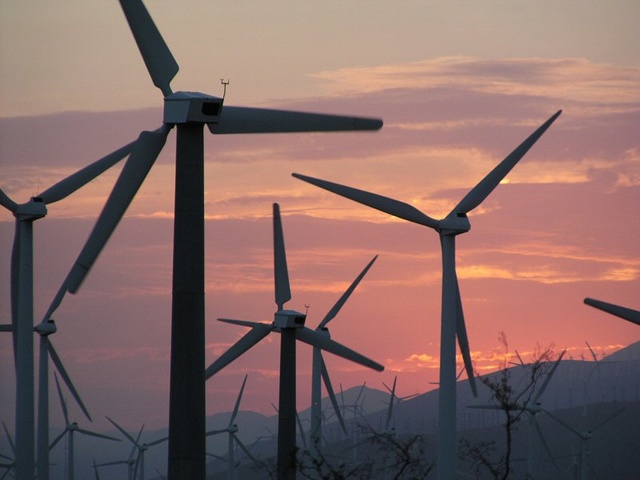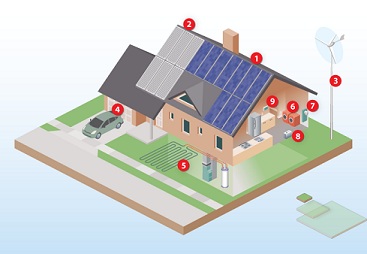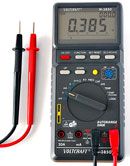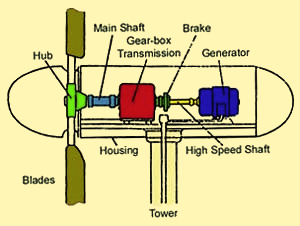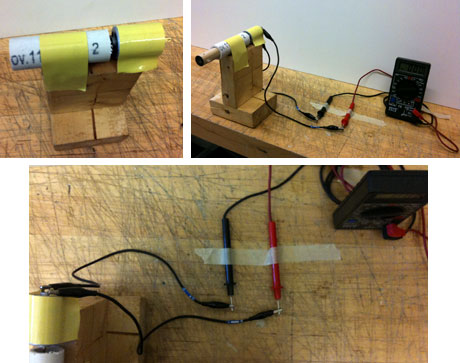Wind Power for Your Home
Activity courtesy of TeachEngineering.org, contributed by the Integrated Teaching and Learning Program, College of Engineering, University of Colorado, Boulder.
Summary
In this activity, students in grades 9-11 learn how engineers harness the energy of the wind by following the engineering design process to create and test two prototype wind turbines. They also learn about where to place a wind turbine for maximum effectiveness, and weigh the advantages and disadvantages compared with other energy sources.
Grade level: 9 – 11
Time: 200 minutes (conduct this as an in-depth design activity over 3 to 4 class periods)
Cost: $3 per group
Engineering Connection
Engineers are responsible for developing, designing, testing, and improving ways in which electricity is generated for our homes and businesses. One way to generate power is to harness the energy of the wind using a wind turbine. Civil, mechanical, and electrical engineers work together to design and test wind turbines, including determining the most ideal locations for wind farms and the most efficient turbine designs for specific conditions.
Related curriculum
Learning Objectives
- Describe how wind turbines transfer the energy of the wind into electricity.
- Compare and contrast two different types of wind turbines.
- Evaluate the advantages and disadvantages for using wind power.
- Use the engineering design process to create prototype wind turbines.
International Technology and Engineering Educators Association
- K. A prototype is a working model used to test a design concept by making actual observations and necessary adjustments. (Grades 9 – 12)
- M. Energy resources can be renewable or nonrenewable. (Grades 9 – 12)
Next Generation Science Standards [High School]
- Energy (Physical Sciences): Design, build, and refine a device that works within given constraints to convert one form of energy into another form of energy.
- Create a computational model to calculate the change in the energy of one component in a system when the change in energy of the other component(s) and energy flows in and out of the system are known.
- Engineering Design: Design a solution to a complex, real-world problem by breaking it down into smaller, more manageable problems that can be solved through engineering.
- Evaluate a solution to a complex, real-world problem based on prioritized criteria and trade-offs that account for a range of constraints, including costs, safety, reliability and aesthetics as well as possible social, cultural, and environmental impacts.
- Ecosytems: Interactions, Energy, and Dynamics
Materials
- A 2-4 inch (5-10 cm) long block of cylindrical wood, at least 3/4 inch (1.9 cm) in diameter, for the horizontal-axis turbine
- A 6-8 inch (15-20 cm) long block of cylindrical wood, at least 3/4 inch (1.9 cm) in diameter, for the vertical-axis turbine
- Wind Turbine Worksheet (pdf; 8 pages)
- 1-2 multimeters or voltmeters
- 2 double-ended alligator clip wire test leads
- 1-2 DC motors (available at RadioShack – suggested part numbers: 273-223, 273-047, or 273-106 – or hobby stores; make sure the shaft does not have a gear on it.)
- drill
- drill bit equal to the diameter shaft of the hobby motor
- two blocks of 2 x 4 wood, each about 5 inches (12.7 cm) long
- two 2.5-inch (6.35 cm) nails or screws
- hammer or screwdriver
- one 3-5-inch (7.6-12.7 cm) piece of PVC pipe with an interior diameter that is slightly larger than the diameter of the blocks of cylindrical wood used for turbine construction
- various materials from which to construct turbine blades, such as foam core board, index cards, plastic bottles, cardboard, particle board, thick poster board, foam board, thin dowel rods, bamboo skewers, etc.
- scissors
- glue
- strong tape, such as duct tape or packing tape
- a house or box fan with three (3) speed settings
See TeachEngineering.org for engineering background/motivation. Click HERE for Wind Turbine Worksheet answers.
Background
[Note: A 49-minute video from KidWind provides comprehensive overview of wind power, from historical irrigation systems to modern wind farms.]
- They cannot start spinning on their own and require a boost from an electrical system, and
- They are held up by wires, limiting their height and thus winds they can access.
Photo: Assemble the class turbine testing device. Nail or screw together the two wooden blocks. Tape the PVC pipe and motor on top of the wooden block base. Connect the motor to a multimeter. Copyright © 2009 Jacob Crosby, ITL Program, University of Colorado Boulder.
Procedure
In advance
- A few days before the activity, have students gather and bring from home a variety of plastic bottles, cardboard and other materials from which turbine blades can be made.
- Gather materials and make copies of the Wind Turbine Worksheet, one per group.
- Drill a hole on one end of each cylindrical block of wood equal in diameter to the diameter of the shaft of the hobby motor. Place the hole as close to the exact center of the wood as possible.
- Assemble the turbine testing device(s) using the wooden blocks, nails or screws, PVC pipe, DC motor, duct tape and alligator clip wires, as shown above.
- In this activity, each group creates a turbine on their own cylindrical block of wood and then takes turns placing their turbines on the class turbine testing device(s) to measure voltage.
With the Students
- Divide the class into groups of two or three students each.
- Distribute the worksheets and blocks of wood.
- In a class discussion, generate the problem that the students are trying to solve by designing wind turbines; this should include how to generate electricity for a house using a renewable energy source.
- In groups, have students brainstorm designs for a vertical-axis turbine and a horizontal-axis turbine Possible questions to ask: How many blades? How to space them? From what material should we make the blades? What shape for the blades? Have students record all their brainstorm ideas on their worksheets.
- From a review of their brainstorming exercise results, have each group choose one vertical and one horizontal design to build for their wind turbine models. Direct them to draw their designs on their worksheets and explain why they chose those designs.
- Next, have each group build their turbines. Use the shorter cylindrical wood blocks for the horizontal-axis wind turbine. Use the longer cylindrical wood blocks for the vertical-axis turbine. Attach the turbine blades onto the side of the wood opposite the side with the hole drilled into it.
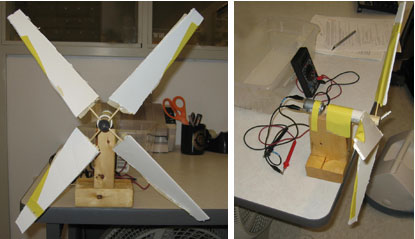 Front and side view of activity set up with a hobby motor and multimeter connected to one team’s block of wood and prototype wind turbine. Copyright © 2009 Jacob Crosby, ITL Program, University of Colorado Boulder.
Front and side view of activity set up with a hobby motor and multimeter connected to one team’s block of wood and prototype wind turbine. Copyright © 2009 Jacob Crosby, ITL Program, University of Colorado Boulder.
7. Once a group has finished building their designs, have them test them. To do this, have them stick the end of the model turbine through the PVC pipe on the testing device and onto the shaft of the motor. You may want to tape the front end of the testing device to the surface it is sitting on in order to prevent movement during testing. Once the turbine is connected, have one student operate the fan at each speed setting.
8. Have each group take turns testing their turbine designs at three different fan speeds, recording the output data on their worksheets.
9. Repeat the testing procedure for the other turbines, again recording the data on their worksheets.
 A student team’s prototype wind turbine design being tested and measured. Copyright © 2009 Jacob Crosby, ITL Program, University of Colorado Boulder.
A student team’s prototype wind turbine design being tested and measured. Copyright © 2009 Jacob Crosby, ITL Program, University of Colorado Boulder.
10. Have students complete the calculations and analysis on their worksheets. [Click HERE for answers to to Wind Turbine Worksheet.]
11. Conclude with a class discussion to review and compare the groups’ findings. What improvements would they make? Where would they locate turbines near their energy-efficient houses?
12. Have student teams present their designs to the rest of the class. They should include descriptions of how well the wind turbines worked, which type of turbine worked best, and what improvements they might make to their designs.
Troubleshooting tips.
Have students research the role of aerodynamics on wind turbines. Assign them to write a paragraph or two on the effects of forces such as lift and drag on modern turbines.
- For younger students, eliminate the mathematical analysis from the worksheet.
- For older or more advanced students, have them write paragraphs detailing the materials and features of their turbine designs and why they designed them the way they did.
Additional resources
Bicycle Wheel Windmill. (VIDEO) Quick DIY project shows one method for creating a wind turbine. [YouTube 1:49]
Exploring Wind Power. This comprehensive list of resources from the National Energy Education Development Project includes a teacher’s guide with curriculum, standards-based activities, and other ideas for learning about wind power.
KidWind Project. Find teacher resources, lessons, students competitions, and more on this site devoted to renewable energy education, including this student produced animation of where wind comes from.
Homemade Wind Generator: How Wind Power Works. (VIDEO) British professor Jonathan Hare uses two backyard models to explain wind power generation. [YouTube 3:09]
National Wind Institute. Texas Tech University’s comprehensive site has information and teachers’ resources on all things wind, including a tornado simulation.
Renewable Energy Living Lab. Discover how wind turbines work, access videos on wind power, and get other information on wind energy at the U.S. Department of Energy’s Office of Energy Efficiency and Renewable Energy.
U.S. Department of Energy’s Wind for Schools Program. A pilot program to power rural schools, the site includes real-time data and teacher resources from more than 100 schools with wind turbines.
US Department of Energy’s Wind Program. Offshore wind technology, wind resource maps and data, and more.
4H: Power of the Wind Online resource to supplement The Power of the Wind National 4-H curriculum designed to help middle school students learn about the wind and its uses; design, build, and test wind-powered devices; and explore wind as a potential energy source.
Wind Energy Basics. A primer from Argonne National Lab.
Wind Lessons. From the American Wind Energy Association.
Wind 101. (VIDEO) Not very glitzy, but KidsWind video on alternative energy covers everything from how many light bulbs a megawatt or kilowatt of energy could power to where and how wind turbines are generating electricity. [Vimeo, 49:23]
Wind Power. eGFI adapted these inquiry-based activities from the PBS show NOW with Bill Moyers. They are designed to help high-school students discover the basics of wind power technology by building and refining a wind turbine.
Wind Turbine Tour. An inside look at a 200-feet Puget Sound Energy generator. [YouTube 2:38]
Contributed by Tyler Maline, Lauren Cooper, Malinda Schaefer Zarske, Denise W. Carlson; Integrated Teaching and Learning Program, College of Engineering, University of Colorado Boulder. © 2007 by Regents of the University of Colorado. Developed under National Science Foundation GK-12 grant no. 0338326
Filed under: Class Activities, Grades 9-12, Grades 9-12, Lesson Plans
Tags: Alternative Energy, Civil Engineering, Class Activities, efficiency, Environmental Engineering, Environmental science, Grades 9-12, Green Technology, kinetic energy, Lesson Plan, Mechanical engineering, renewable energy, STEM education, Sustainability, turbine, wind power









